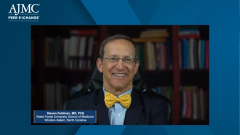
Pros and Cons of Utilizing Telehealth for Treating Acne
A conversation on the pros and cons of telehealth in acne treatment.
Episodes in this series

Casey Butrus, PharmD: Lastly, [Dr Baldwin], I’d like [to] transition to you, I know the COVID-19 pandemic changed how we manage diseases, especially acne. How have you implemented telemedicine into your current practice? And do you think it has a role going forward as we come out of the pandemic in patients with acne?
Hilary Baldwin, MD: I’ll tell you, it’s completely changed my acne [treatment] life. I was dead set against telemedicine. I thought it was too impersonal. I thought gaining trust was going to be more difficult. I believe very strongly in literally the laying of hands. We’ve all had the experience of touching the skin of an acne psoriatic or atopic dermatitis patient, touching their skin and having them recoil and say, “Gosh, don’t you want to put gloves on before you touch me?” Because the implication was that they thought that they were contagious. It just broke my heart and taught me to always touch people’s skin. Ask permission first, but always touch their skin. I thought that was a very important part. Anyway, turns out I was wrong, acne is uniquely suited to telemedicine. You can get great photographs. I can see exactly what I’m talking about. I can zoom in and really see pores. It’s quite amazing to me. I think the teenagers are more comfortable, honestly. They’re sitting on their sofa and not in a paper robe on a paper chair, and they’re used to looking at devices. So now they’re actually looking me in the eye while they’re talking to me, which never happens with a teenage boy, ever. So now we’re actually looking eye-to-eye. They’re happy because it costs less. I live in New York City, they don’t have to park, and they don’t have to get on the grubby subway. They can have meetings on Sunday at 8 o’clock at night. I can do it in my pajamas. I’m in love with this entire concept; I think it works really well. The only problem with it for me is that—I think you taught me this, [Dr Feldman,] way, way, way back—[at] the end of every visit with a parent and a child, I like to have a triangular visit where all of us are sitting literally in a triangle, not looking at any devices, talking to each other and having that final pact, the agreement that we made for the regimen. “And this is your job and this is my job and this is your job and together we’re going to make you better, junior,” and that can’t be done. At least I haven’t figured out a way to do it with televisits, but otherwise, I’m completely happy with it. And that sense of accountability that you were talking about before, [Dr Feldman], is exactly what you get from that triangle. So I haven’t quite figured out how to do that yet.
Steven Feldman, MD, PhD: I suspect if you just asked that teenager to make it a 3-way FaceTime call, they’d figure it out.
Hilary Baldwin, MD: Yeah, probably. I’m just too dumb to do it. You’re right.
Casey Butrus, PharmD: And I think, as [Dr Feldman] mentioned, if you are having that 1-week follow-up visit, even every 2 weeks, having a virtual option is really beneficial. So those indirect costs of maybe missed work time or the costs of transportation may not be accessible, especially to people in more rural areas or with lower socioeconomic status. So I think it is definitely helping to break some of those social determinants of health barriers that we previously had when we didn’t utilize telemedicine as much. So I think the future looks exciting and hopefully transitioning from a post-COVID-19 world, we can continue to use this in our practice.
Transcript edited for clarity.
Newsletter
Stay ahead of policy, cost, and value—subscribe to AJMC for expert insights at the intersection of clinical care and health economics.








































